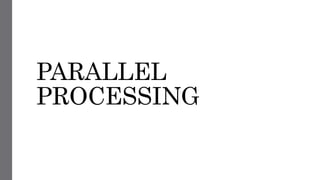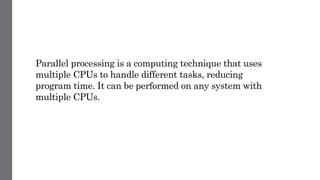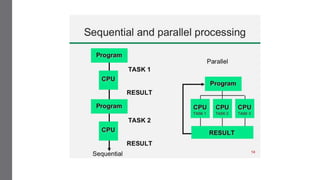Components of Computer PARALLEL-PROCESSING.pptx
- 1. GROUP 6 ROLEX ZHYRONNE BATICAN JHON VINCENT PEJANER HANNAH GINGOYON
- 2. TOPIC • PARALLEL PROCESSING • TYPICAL MULTI PROCESSING CONFIGURATION
- 5. Parallel processing is a computing technique that uses multiple CPUs to handle different tasks, reducing program time. It can be performed on any system with multiple CPUs.
- 7. • Parallel processing divides a task between at least two microprocessors, using specialized software to break down complex problems into components and designate processors for each part, reassembling data for solving the initial challenge. • Parallel processing breaks large tasks into smaller ones, utilizing software to keep each processor updated on their progress, ensuring efficient use of available processing units.
- 10. • SINGLE INSTRUCTION, SINGLE DATA (SISD) • MULTIPLE INSTRUCTION, SINGLE DATA (MISD) • SINGLE INSTRUCTION, MULTIPLE DATA (SIMD) • MULTIPLE INSTRUCTION, MULTIPLE DATA (MIMD) • SINGLE PROGRAM, MULTIPLE DATA (SPMD) • MASSIVE PARALLEL PROCESSING (MPP)
- 11. SINGLE INSTRUCTION, SINGLE DATA (SSID) SISD computing involves a single processor managing a single algorithm and data source, similar to a serial computer. It may or may not support parallel processing.
- 12. MULTIPLE INSTRUCTION, SINGLE DATA (MISD) MISD computers use multiple processors, sharing input data, allowing simultaneous operations on the same batch, with the number of processors affecting the number of operations.
- 13. SINGLE INSTRUCTION, MULTIPLE DATA (SIMD) SIMD architecture computers use multiple processors with identical instructions, each providing unique data sets. These components are supervised by a single control unit, allowing simultaneous communication with each CPU.
- 14. MULTIPLE INSTRUCTION, MULTIPLE DATA (MIMD) MIMD computers have multiple processors that can accept instructions and draw data from different streams. They can run multiple tasks simultaneously, but developing sophisticated algorithms is challenging. MIMD computers incorporate interactions between multiprocessors, making them more adaptable than SIMD or MIMD computers.
- 15. SINGLE PROGRAM , MULTIPLE DATA (SPMD) SPMD systems, a subset of MIMD, are message passing programming used in distributed memory computer systems. These systems consist of nodes that launch applications and use send/receive routines to communicate. They can also use messages for barrier synchronization and transfer via various communication techniques.
- 16. MASSIVE PARALLEL PROCESSING (MPP) Massively Parallel Processing (MPP) is a storage structure that coordinates program execution by multiple processors, allowing for faster data handling and analysis. MPP systems use SIMD and MIMD computers, with clusters created by connecting multiple processors. In more extensive parallel systems, each CPU can function as a processor, creating a single supercomputer called grid computing.
- 19. WHAT IS TYPICAL MULTI PROCESSING CONFIGURATION?
- 20. Multiprocessing involves multiple processors working together, requiring proper configuration to prevent problems. There are three common configuration types: Master/Slave, Loosely Coupled, and Symmetric.
- 21. MASTER SLAVE The master/slave configuration is a single processor system where extra slave processors work, managed by the primary master processor. It's an asymmetrical system, suitable for computing environments where processing time divides between front and back end processors.
- 22. MASTER SLAVE
- 23. ADVANTAGE : • IT IS SIMPLE TO UNDERSTAND DISADVANTAGE : • It is as reliable as a single processor system, if the master processor fails the entire system fails. • It creates more overhead charges. There would be situations when the slave processors would be free before the master processor could assign them another task. Then it takes the valuable time of processing. • After each task completed by the slave processors, it interrupts the master processor for some operating system intervention, like I/O requests. This creates long queues at master level processor.
- 24. LOOSELY COUPLED CONFIGURATION In this type of configuration, there are several complete computer systems with their own memory, I/O devices, CPU and operating system.
- 25. ADVANTAGE : • It isn’t prone to catastrophic failure DISADVANTAGE : • It is difficult to detect if a processor has failed.
- 27. SYMMETRIC CONFIGURATION In symmetric configuration processor scheduling is decentralized. A single copy of the OS and a table listing each process and it’s status is stored in memory common and accessible to all the processors, so that each processor can use the algorithms to decide which job to run next.
- 28. ADVANTAGE : • It is more reliable than loosely coupled configuration. • It uses the resources effectively. • It well manages the load of jobs. • It can degrade gracefully at the time of failure. DISADVANTAGE : • Interrupted processes cause processors to update process lists, causing conflicts between them. This increases the likelihood of simultaneous execution of tasks like I/O requests. • Implementing this configuration is challenging due to the need for optimal system synchronization to prevent races or deadlocks.
- 30. SUMMARY OF THE REPORT NO COMMENT





























